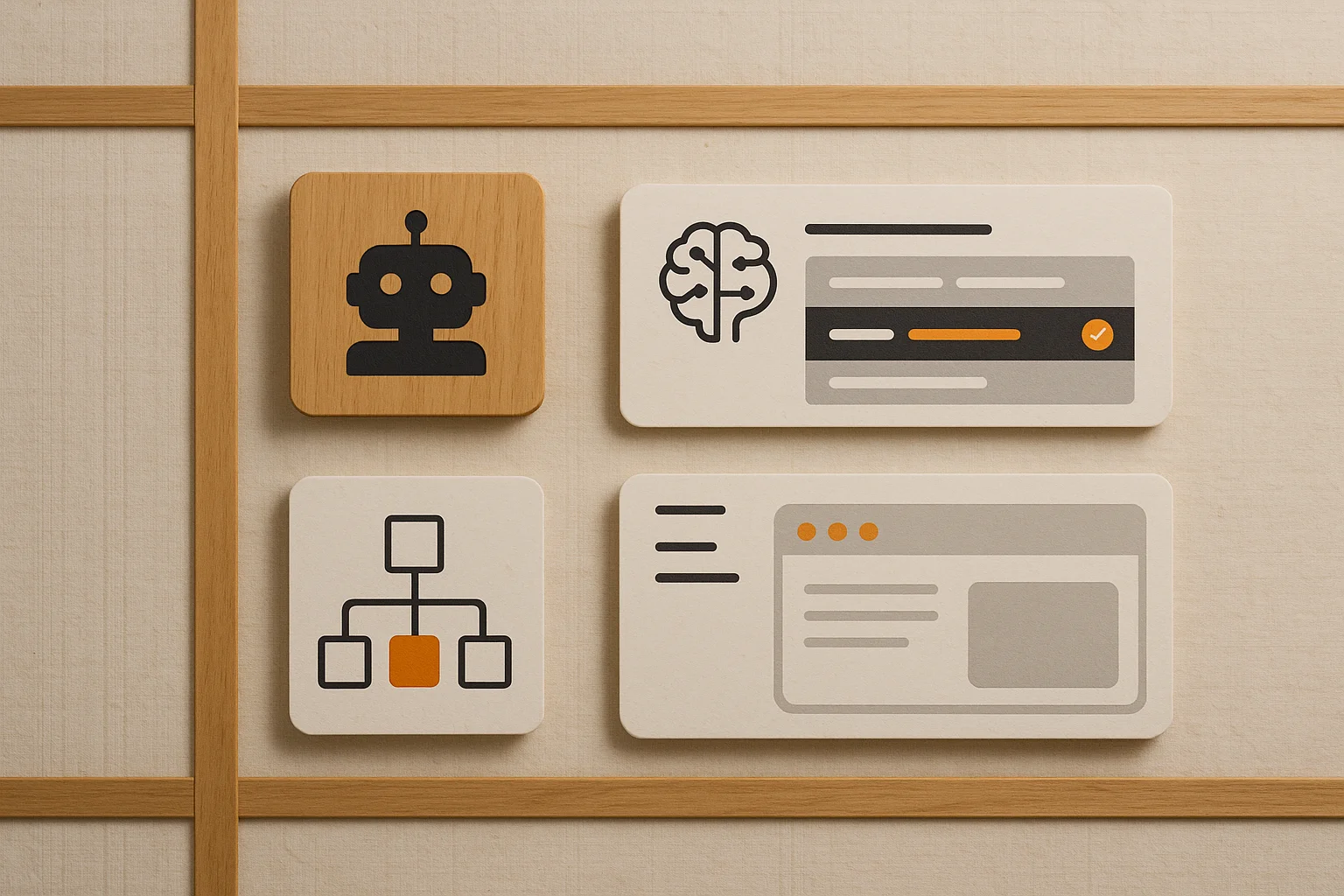Streamline Code Reviews with AI Pull Request Automation

Let's face it, pull requests can be a mixed bag. Sometimes they're smooth sailing, other times they feel like an uphill battle. But what if there was a way to make the entire process more efficient and less stressful? AI pull request automation is emerging as a powerful tool for development teams, offering a way to automate tedious tasks, improve code quality, and accelerate the review cycle. Join me as we explore how AI is changing the landscape of code review, from automating analysis and feedback to enhancing collaboration and reducing developer workload. This post will give you a practical understanding of AI pull request automation and how it can benefit your team.
Key Takeaways
- •AI-driven code review tools accelerate development: Automating tasks like analysis and feedback frees developers to tackle more complex challenges, leading to faster releases and higher-quality code. Choose tools that integrate seamlessly with your version control system and allow customization to fit your team's workflow.
- •Successful implementation requires the right tool and approach: Consider your team's needs and the programming languages you use when selecting a tool. Start with a pilot project and gather feedback before wider adoption. Clear communication and training are key for team buy-in.
- •AI empowers developers to focus on what matters: While AI automates many code review tasks, human expertise is still critical. Train your team to use these tools effectively and foster a culture of continuous learning. AI acts as a powerful assistant, helping developers produce better code more efficiently.
What is AI Pull Request Automation?
AI pull request (PR) automation uses artificial intelligence to streamline and improve the code review process. Think of it as having a highly skilled assistant helping manage your pull requests. These AI-powered tools analyze code changes, offer feedback, and suggest improvements, accelerating the review cycle and enhancing code quality. This automation frees developers to focus on more complex tasks, rather than getting bogged down in tedious review processes.
What is AI-Driven Code Review?
AI-driven code review takes traditional code review and enhances it with artificial intelligence. Instead of relying solely on human reviewers, AI provides an initial layer of analysis. Tools like GitHub Copilot explore how AI can improve this process, reducing the time and effort required for creating and reviewing pull requests. This means faster turnaround times and more efficient use of developer resources. AI can identify potential bugs, suggest best practices, and ensure adherence to coding standards, all before a human reviewer even looks at the code.
How Machine Learning Automates PRs
The power behind AI pull request automation lies in machine learning. These systems learn from vast amounts of code and use this knowledge to analyze incoming pull requests. The Modern AI tools demonstrate how automation can streamline PR analysis, feedback, and suggestions to expedite code reviews. These solutions typically use webhooks to trigger cloud functions that can clone repositories, analyze code changes, and automatically generate comprehensive feedback. This automation handles repetitive tasks, allowing developers to focus on higher-level work and complex problem-solving.
How AI Pull Request Automation Works
AI-powered pull request (PR) automation transforms how development teams review and manage code changes. By integrating directly into your existing workflow, these tools act like an intelligent assistant, streamlining the entire process from initial commit to final merge. Let's explore the core components that make this possible.
Key Components of AI PR Tools
Modern AI PR tools utilize a combination of techniques to provide valuable support during code reviews. Sophisticated algorithms analyze code changes, comparing them against project history, coding standards, and even best practices gleaned from a vast dataset of open-source projects. Think of tools like GitHub Copilot for Pull Requests, which uses prompts within the PR description to generate summaries and offer insights. These tools can automatically flag potential bugs, suggest improvements, and even generate initial code reviews, freeing up developers to focus on more complex issues. Some tools offer specific commands (e.g., /review, /describe, /improve) to trigger different automated actions within the PR, further enhancing the level of control and customization. This targeted approach ensures that developers receive relevant and actionable feedback, leading to more efficient and effective code reviews.
Integrating with Version Control Systems
Seamless integration with your existing version control system (VCS) is crucial for any AI PR automation tool. Most tools are designed to work with popular platforms like GitHub, GitLab, and Bitbucket. This integration allows for automated workflows triggered by events like creating a pull request or pushing code changes. For example, a tool might automatically generate a summary of changes using a marker like copilot:summary in the PR description. Other tools offer flexible integration options , including command-line interfaces (CLIs), GitHub Actions, and Docker, allowing teams to tailor the integration to their specific needs. Even more advanced integrations can automate the entire process from code modification to PR creation, showcasing the potential for end-to-end automation. This level of integration ensures that AI PR automation becomes a natural extension of your development workflow, rather than a disruptive addition.
Benefits of AI-Powered Pull Request Automation
Using AI to automate parts of your pull request (PR) workflow can significantly impact your team's productivity and the quality of your code. Let's explore some key advantages:
Accelerate Code Review Processes
AI can handle many of the tedious aspects of code reviews. Tools like AI-powered tools automate routine tasks, freeing up developers to focus on more complex issues. This reduces the time it takes to review and merge pull requests, as highlighted by GitHub Next's work on Copilot for Pull Requests. Faster code reviews mean faster iteration cycles and quicker deployments, allowing your team to ship features more frequently and respond to market demands more effectively.
Enhance Code Quality and Consistency
Automating your pull request workflow with AI not only speeds up the process but also helps maintain high code quality. AI can identify potential bugs, vulnerabilities, and style inconsistencies that might be missed in manual reviews. By catching these issues early, you prevent them from making their way into production, leading to more robust and reliable software. Consistent code is easier to understand and maintain, as described in these pull request best practices. AI-powered tools can even generate improved code suggestions, helping developers learn and improve their skills.
Reduce Developer Cognitive Load
Code reviews can be mentally taxing, requiring developers to juggle multiple tasks and keep track of numerous details. AI can alleviate some of this cognitive burden by automating repetitive tasks and providing helpful suggestions. This allows developers to dedicate their mental energy to the more challenging and creative aspects of software development. The goal is to assist programmers, not replace them. This idea is reinforced in discussions around AI augmentation in business, where the focus is on enhancing human capabilities with AI tools. By reducing cognitive overload, AI-powered pull request automation helps developers stay focused, make better decisions, and produce higher-quality code.
Customize Rule Sets and Preferences
Every team has its own coding standards and best practices. A good AI PR automation tool should allow you to customize its rule sets and preferences to match your specific requirements. This ensures the automated feedback aligns with your internal guidelines, promoting consistency and quality across your codebase. Tabnine's Code Review Agent allows teams to enforce their unique standards, leading to more efficient and consistent code reviews. This level of customization is key for integrating AI seamlessly into your existing workflow. It also helps ensure the tool is a valuable asset, not just another source of generic feedback.
Essential Features of AI PR Automation Tools
Looking to streamline your code review process? Here's what to look for in an AI-powered pull request (PR) automation tool. These features can significantly improve your team's workflow and the quality of your code.
Automate Code Analysis and Feedback
Effective AI PR tools automatically analyze code changes within a pull request, providing feedback on potential issues, bugs, and areas for improvement. Think of it as an extra set of eyes, catching things that might otherwise be missed. This automated analysis reduces the time developers spend on manual reviews, freeing them up for more strategic work. Tools like PR-Agent offer automated analysis and suggestions to accelerate the code review process. This automation allows your team to focus on higher-level discussions and architectural considerations.
Natural Language Processing Capabilities
The ability to understand and process human language is crucial for AI PR tools. This allows the tool to generate summaries of code changes, explain complex logic, and even provide walkthroughs of proposed modifications. Clear explanations help reviewers quickly grasp the context and implications of changes. GitHub Copilot for Pull Requests uses markers in the PR description to generate summaries and explanations, making it easier for reviewers to understand the context of the changes. This natural language processing makes the review process more efficient and accessible.
Best Practices for Integration
Once you've chosen a tool, smooth integration is crucial. Start with a pilot project, perhaps with a smaller team or a single repository, to test the tool and gather feedback. Establish clear communication with your team about the goals of using AI PR automation. Focus on how it can improve their workflow and free up time for more strategic tasks, rather than replacing their expertise. A strong code review culture is about continuous improvement and learning, and Mergify offers insights into best practices. AI can be a valuable asset in this process. Gradually roll out the tool to other teams and repositories, incorporating feedback and making adjustments along the way. Monitor key metrics like code review time, defect rate, and developer satisfaction to measure automation's impact.
Train Your Team on AI-Assisted Workflows
Team training is essential for successful adoption. Address any concerns about AI taking over their jobs head-on. Explain how the tool will augment their capabilities, allowing them to focus on higher-level tasks. Provide clear documentation and training sessions on how to use the tool effectively. Encourage experimentation and feedback. Education is key to building trust and demonstrating the value of AI. Highlight success stories and demonstrate how the tool has helped improve code quality or reduce review time. Foster a culture of continuous learning and improvement, where the team sees AI as a partner in their work.
Limitations and Challenges of AI PR Automation
While AI-powered pull request (PR) automation offers significant advantages, it's essential to acknowledge its current limitations. Understanding these constraints helps manage expectations and ensures successful implementation.
Handling Complex Codebases and Limited Context
One of the primary challenges lies in handling complex codebases. AI-driven tools excel at analyzing discrete code changes, but their understanding of broader project context, intricate dependencies, and large-scale systems is still developing. Current proof-of-concept projects work best with straightforward code modifications. Applying AI effectively to complex projects requires further advancements in contextual awareness.
Balancing AI Suggestions with Human Expertise
AI can significantly reduce the time spent creating and reviewing pull requests, but it shouldn't replace human oversight. GitHub Next's work on Copilot for Pull Requests emphasizes this balance. AI excels at identifying potential issues and suggesting improvements, but experienced developers still play a crucial role. They evaluate suggestions within the larger project scope, consider non-technical factors, and make informed decisions. Think of AI as a powerful assistant that augments human capabilities, not a replacement for engineering expertise.
Ensuring Security and Data Privacy
Data security and privacy are paramount when integrating AI tools into your workflow. Many AI PR automation tools rely on external APIs, raising concerns about how code and project data are handled. Open-source tools like Leading AI code review tools highlight the importance of understanding data flow. When evaluating tools, consider that open-source solutions' privacy often depends on your API key and provider policies, while hosted versions may offer different data retention policies. Carefully evaluate the data handling practices of any AI tool to ensure alignment with your organization's security standards.
Frequently Asked Questions
What's the difference between AI-powered code review and traditional code review?
Traditional code review relies solely on human reviewers to examine code changes, while AI-powered code review uses AI to provide an initial layer of analysis, identifying potential issues and suggesting improvements before a human even looks at the code. This speeds up the process and helps catch errors early. Human reviewers then focus on higher-level aspects and more nuanced considerations.
How do I choose the right AI PR automation tool for my team?
Consider your team's specific needs, the programming languages you use, and your budget. Some tools specialize in certain languages, while others offer broader support. Look for seamless integration with your version control system (like GitHub, GitLab, or Bitbucket) and CI/CD pipeline. Start with a pilot project to test a few different tools and gather feedback before fully committing.
Is AI going to replace human code reviewers?
No. AI serves as a powerful assistant, automating tedious tasks and providing valuable insights, but it doesn't replace human expertise. Experienced developers are still essential for evaluating AI's suggestions within the larger project context, considering non-technical factors, and making informed decisions.
What are the main security considerations when using AI PR automation tools?
Data security and privacy are crucial. Carefully evaluate the data handling practices of any AI tool you consider. Understand where your code and project data are being processed and stored, and ensure these practices align with your organization's security standards. Look for tools with transparent data policies and robust security measures.
How can I ensure my team successfully adopts AI-powered pull request automation?
Start with a pilot project and clear communication. Focus on how the tool will improve workflows and free up time for more strategic tasks. Provide thorough training and documentation. Address any concerns about job displacement head-on, emphasizing that AI augments human capabilities, not replaces them. Encourage feedback and continuously iterate on your implementation strategy.
Ready to Transform Your Code Review Process?
See how Propel's AI-powered code review helps engineering teams ship better code faster with intelligent analysis and actionable feedback.


